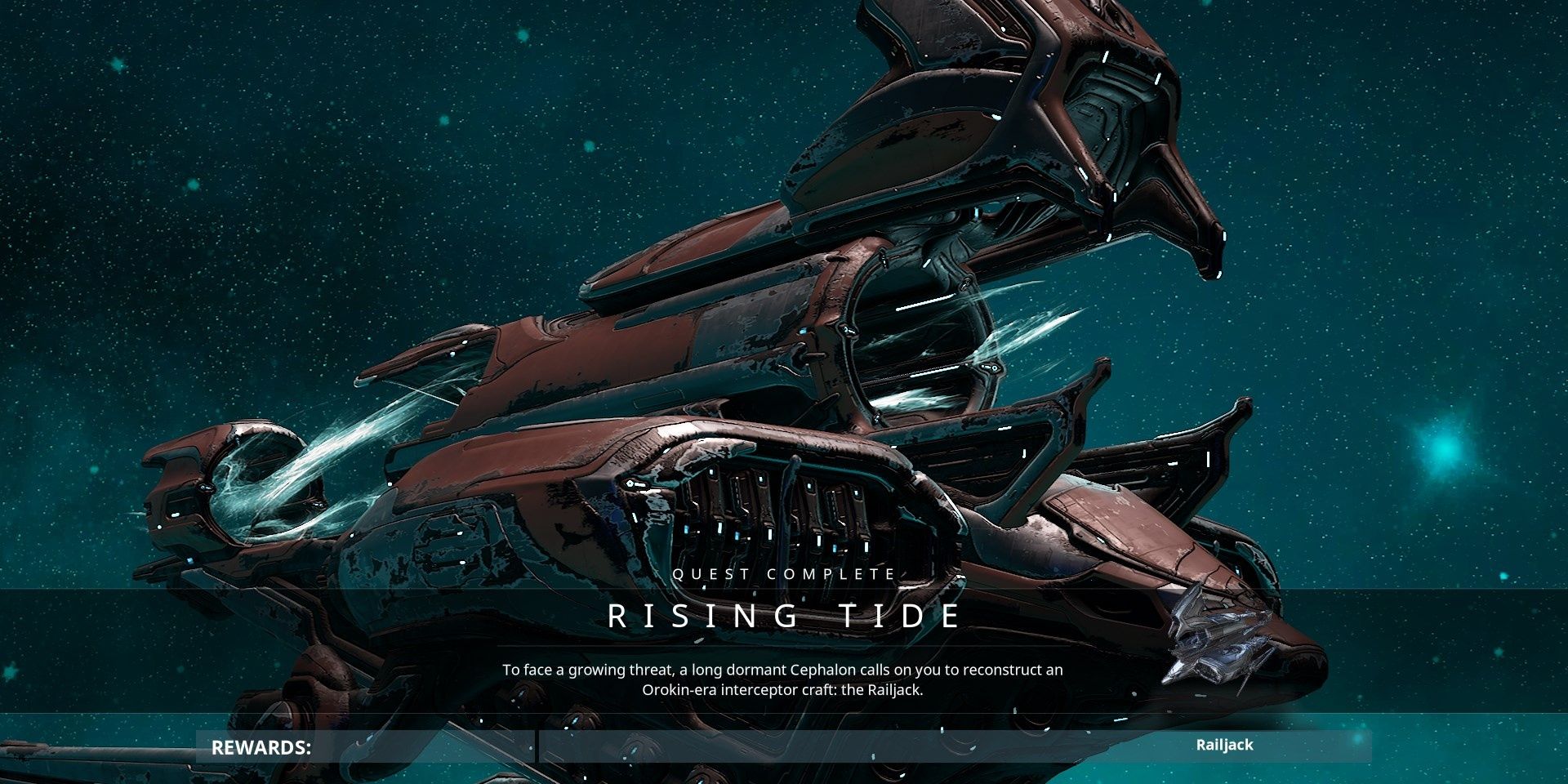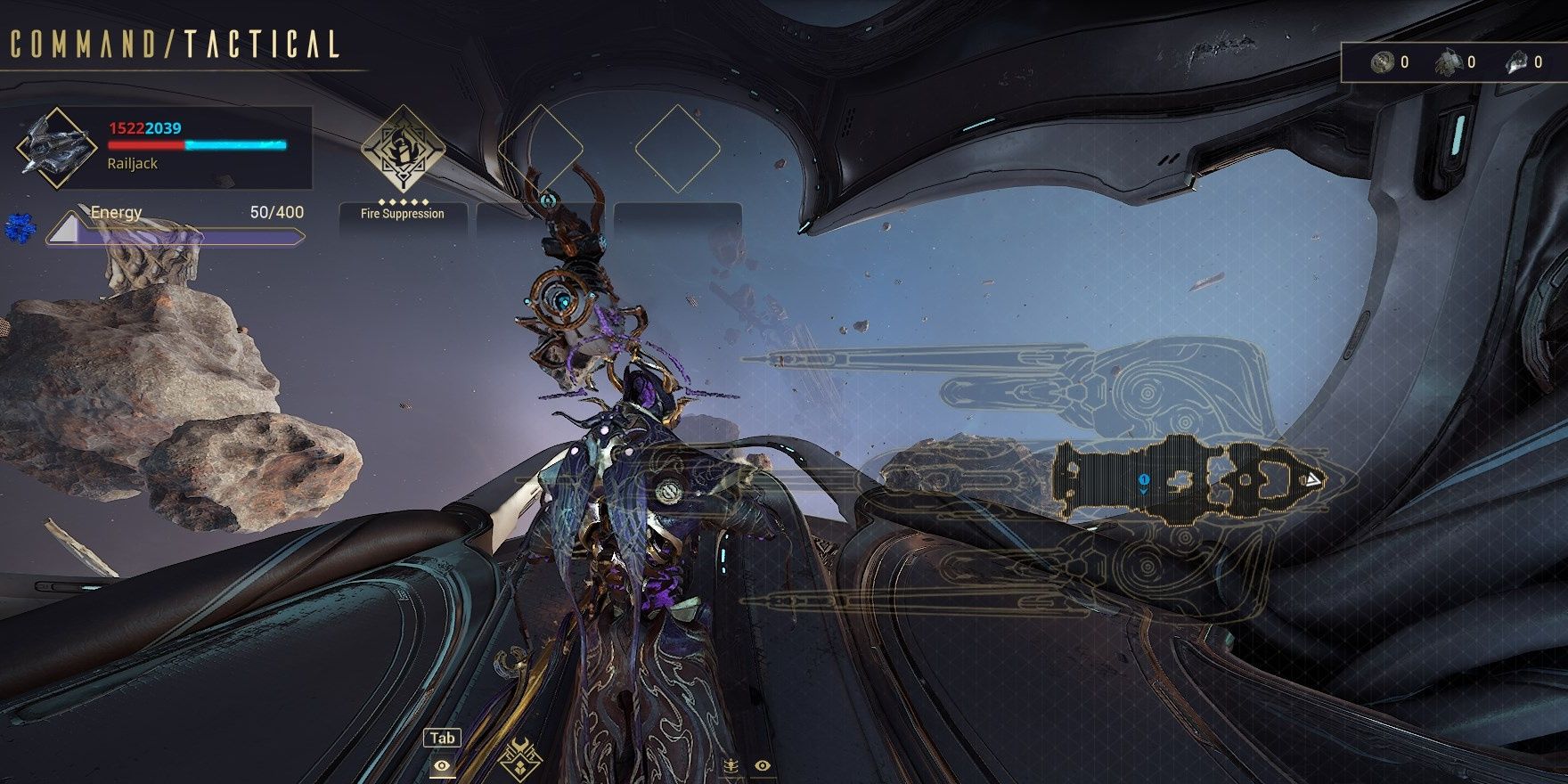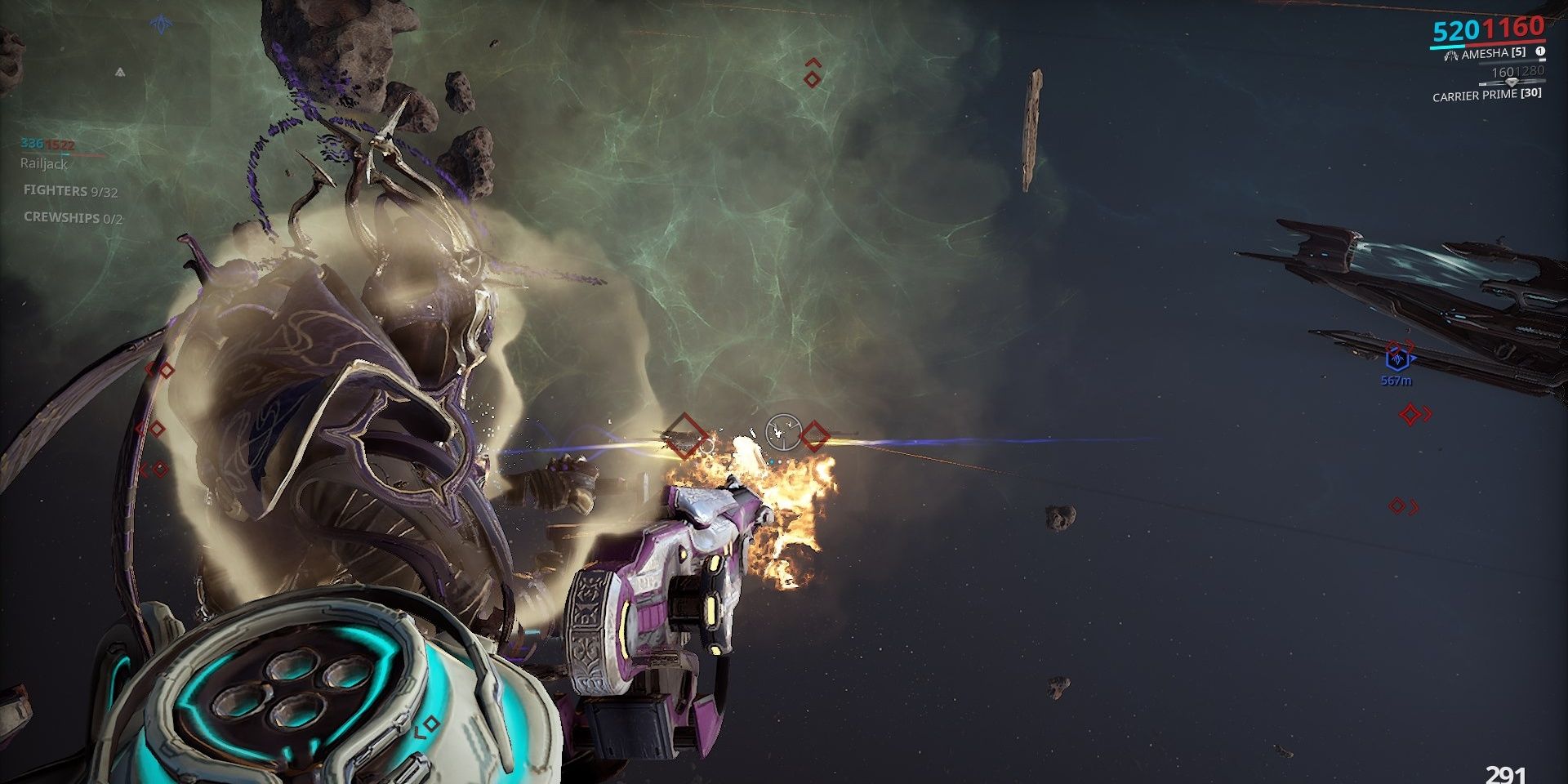Quick Links
Warframe is no stranger to change. Each year, Digital Extremes will release multiple updates that range from small bug fixes to fundamentally changing how a part of Warframe works. In update 29.10, the developers have given yet another rework to Railjack.
In essence, Railjack has been streamlined to work much closer to how the rest of Warframe operates, now utilizing Mods and standard damage types to lessen the learning curve. While it has certainly made things easier to grasp, Railjack is still a complex beast that can be difficult to understand. Thankfully, that’s what this guide is for. Let’s go over how to get a Railjack, how to upgrade one, and a quick rundown of how to use them.
Updated December 20, 2024, by Charles Burgar: Railjack has seen some minor changes since its initial rework in Update 29.10. We’ve updated this guide to include up-to-date information on creating your own Railjack vessel as well as upgrading it.
What’s A Railjack?
Railjacks are spaceships that up to four Tenno can control at once. Unlike Archwings, Railjacks have multiple “stations” that will require a player’s attention. You can pilot a Railjack, man a side turret, focus on repairing critical damage, or craft ammunition and other valuable resources from the Railjack’s rear forge.
The Railjack itself is a hybrid between a Warframe and an Archwing. It has three unique abilities, multiple weapons you can fire, and the omnidirectional movement you’d expect from a spaceship. They also share an upgrade system that draws parallels from your Warframe’s Modding system.
Why Do I Need A Railjack?
An entire second star chart, typically referred to as the Empyrean star chart, is tied to using Railjacks. You can complete these missions without one by joining a public lobby, although you’ll be at the mercy of what the host equips on their spacecraft. Two Warframes, Ash and Oberon, are also tied to Railjack missions. You can even earn Arcanes from the Orphix game type exclusive to the Empyrean star chart.
You’ll also need a Railjack to complete some of Warframe’s mainline quests, notably “The New War.” If you want to progress through the main story and unlock access to some of Warframe’s more recent content updates, then you’ll need access to a Railjack.
How To Build A Railjack
Building a Railjack is significantly easier than it was when the Empyrean update was first released. As with most systems in Warframe, there’s a free path and a means of skipping it by spending Platinum—the game’s premium currency.
You can obtain a Railjack through the following means:
- Complete the “Rising Tide” quest.
- Purchase a Railjack from the in-game market (costs 400 Platinum).
Those that haven’t played Warframe extensively should know that you can obtain Platinum for free by trading with other players. With that said, the “Rising Tide” quest is fairly easy and doesn’t take much time to complete.
Rising Tide Quest
In this quest, you’ll be having to scavenge for the six core components that make up a Railjack. Before you go hunting for Old War parts, you’ll first need a Railjack Cephalon and Dry Dock. As of Update 29.10, certain Relays have Dry Docks attached to them. You should be able to enter a Relay’s Dry Dock to build the Railjack Cephalon to start this quest. If not, you’ll need to join a clan to build a Dry Dock.
Once you’ve crafted the Cephalon, you’ll be introduced to Cephalon Cy. He will guide you through finding and building a proper Railjack. The rest of the quest will be a series of low-level missions (level 20-35) asking you to defend a crashed Railjack piece. When you complete a mission, you must travel to a Dry Dock to craft the piece you just uncovered.
Each component takes 2-5 minutes to craft.
When the part is crafted, Cy will ask you to recover another piece. Build a piece, find another, rinse and repeat. Build all six Railjack parts to complete the quest.
Here are the crafting components for building a Railjack. Parts are listed in the order you obtain them.
|
Fuselage |
|
|---|---|
|
Propulsion |
|
|
Port Nacelle |
|
|
Starboard Nacelle |
|
|
Tail Section |
|
|
Engine Cowling |
|
150,000 Credits is a tall order for newer players. If you lack Credits to build a given part, farm the Index on Neptune. This will give you millions of Credits in just a few runs.

Related
Warframe: Wolf Of Saturn Six Boss Fight Guide
The Wolf of Saturn Six is a tough optional boss in Warframe. Let’s check out his weaknesses and rewards in this guide.
Upgrading Your Railjack
Update 29.10 made some radical changes to how gearing works for your Railjack. In essence, your Railjack behaves similarly to a Warframe loadout. You equip unique Railjack Mods, weapons, and auxiliary items such as thrusters.
The Plexus: Railjack’s Version Of Modding
Modifying your Railjack’s stats is done through “The Plexus.” This is just a fancy term for the Railjack’s Modding menu. Just like your Warframes, Railjacks have eight main Mod slots and an Aura slot you can use to customize its effectiveness. Railjacks have an Orokin Reactor pre-installed, meaning you’ll have up to 60 points to work with by default. You increase your Railjack’s Mod capacity by earning Affinity (XP) during Railjack missions. Your Railjack’s level is noted as the “Plexus” item in your inventory at the end of a mission.
Unlike Warframes, Railjacks have two additional Mod menus you can tweak. There are three tabs in the Plexus menu: Integrated, Battle, and Tactical. Integrated Mods are what you’d expect from a Moddable item, giving you passive boons to your Railjack and its guns. Battle Mods are your Railjack’s abilities, allowing you to summon void holes or tether enemies together. Finally, Tactical Mods are abilities that can only be accessed via the Railjack’s Tactical menu (opened by pressing “L” mid-mission on PC). Tactical abilities provide utility effects such as extinguishing fires automatically or freezing boarding parties.
Integrated and Battle Mods do not follow Warframe’s traditional Modding flexibility. The Polarities/symbols on these cards can only be applied to slots that match said symbol. This limits your ability to mix and match these Mods, but both Mod types don’t drain any Mod capacity as compensation.
All Railjack Mods can be found by defeating Railjack enemies and completing Railjack missions. Railjack Mods are upgraded with Credits and Endo. You can also apply Forma to polarize Railjack Integrated slots, allowing you to equip more powerful Mods for less Mod capacity. As with all other items in Warframe, applying Forma to a Railjack will reset its rank.
Your Railjack’s Mod setup carries over to other players’ Railjacks. Whenever you commandeer a Railjack, your Mods will automatically apply to the Railjack, allowing you to carry over progress across multiple lobbies. The host’s Railjack setup still determines its equipped weapons and auxiliary parts.
Armaments And Components
Armaments are your Railjack’s equipped weapons. Similar to your Warframe, Railjacks can equip three weapons at a time. The first weapon is for the pilot, the second weapon is for your turrets, and the third weapon is the pilot’s alternate fire. Railjack weapons use the same damage types as your standard weapons (Slash, Toxin, etc.).
Components are pieces of your Railjack that determine its durability, the effectiveness of its abilities, and how fast it can move. Players can change out the following:
- Shield Array: Determines the Railjack’s shield strength and regeneration.
- Engines: Determines the Railjack’s maneuverability.
- Plating: Determines the Railjack’s health and armor.
- Reactor: Determines the effectiveness of Battle Mods.
All Armaments and Components come in one of two types: Sigma and a House variant. Sigma variants are bog-standard items that can be researched and crafted in a Clan Dojo. House variants can only be found in Railjack missions, and they come with slightly randomized stats and unique attributes determined by the House in question. All variants have three tiers that determine their effectiveness. Tier III items are the best and, excluding Sigma items, come with a unique trait.
In simpler terms, you can make a Tier III Railjack just by researching items, but the best Railjack parts can only be found by playing Railjack content. Should you find a better item than what you’re currently using, you can dismantle old Armaments and Components for materials or Endo via the Railjack customization menu in a Dry Dock.
For a comprehensive list of what each Armament and Component does, consult the Warframe Wiki.
Armament Houses
Each armament and component you find for your Railjack will have a listed House, otherwise known as the component’s manufacturer. Each House has unique pros and cons for each of their components, ranging from firearms to armor plates for your ship.
- Sigma: Standard issue. No unique pros or cons.
- Lavan: Maximizes one stat at the cost of another. Engines boost faster but have low initial speed, shield capacity is maxed but with low charge rate, etc.
- Vidar: Same as Lavan, but the stat priority is inverted.
- Zetki: Best-in-class weapons and reactors, although their weapons overheat more quickly.
Intrinsics
Intrinsics are passive skills that you’ve unlocked by playing Railjack missions. They are tied to your account, meaning they are everpresent regardless of your Warframe or Railjack loadout, hence the name.
There are five Intrinsic types in Warframe:
- Tactical: Allows you to use Tactical Mods more often, teleport to your Railjack immediately, deploy Warframe abilities as tactical support, and use your Necramech in Railjack missions.
- Piloting: Improves your mobility options in your Railjack and Archwing.
- Gunnery: Enhances the damage and usability of Railjack weapon systems. This also buffs the damage of your Archwings and Necramechs.
- Engineering: Mend and forge items in a Railjack much faster. It also bolsters the defenses of your Archwings and Necramechs.
- Command: Hire NPCs to take the place of real players. Liches can also be used as Defender Crew members. This tree has no effect in four-player squads.
You can access your Intrinsics menu from the Plexus Modding menu or while modifying your Railjack from a Dry Dock. Investing in Intrinsic trees requires Intrinsic points. You earn Intrinsic points by earning Affinity—Warframe’s name for XP—in Railjack missions. Each Intrinsic tree has ten ranks. You can reach rank ten in all five trees, although this will take quite a few Intrinsic points and Affinity farming. If you play with a team, consider designating certain players into certain roles to reap the benefits of this system more quickly.
Using Your Railjack
Every Railjack has the same interior, stations, and exit points. Take note of the following stations on your ship:
- Pilot Seat: Found in the bow/front of the ship
- Forward Artillery: A massive cannon that annihilates enemy cruisers. This is directly behind the Pilot Seat in the front room of the ship.
- Turrets: Two turrets can be found in the central room, directly behind the room with the pilot seat. One turret is at the front end of the room, and the second turret is at the back end.
- Exit: Found in between the turrets in the central room. There are two additional exits to the sides of the loading ramp at the stern/tail end of the ship.
- Archwing Slingshot: Requires rank three Gunnery. This can be found at the very top of the ship. The slingshot will launch you in the direction you’re aiming, entering enemy ships if your Gunnery rank is high enough.
- Forge: Found at the stern/tail end of the ship. Four forges can be used independently of one another.
In most teams, you’ll want to have one pilot, someone who’s always on the ship—repairing malfunctions or forging items—then two players can use their Archwings, man the forges, or control one of the Railjack’s turrets.
If you’re playing solo, we highly recommend that you complete the first few levels in your Archwing, leaving your Railjack as soon as the mission starts. This is due to the low durability of your ship while starting out. Get a few upgrades and Intrinsic upgrades before you charge into the fray with your spaceship.
Piloting
Piloting a Railjack is similar to an Archwing. You can use the jump button to ascend, crouch button to descend, and move omnidirectional through the environment. Railjacks are somewhat cumbersome to control when starting out, so try not to get swarmed by multiple fighters unless you have another player or NPC controlling a turret. With enough Piloting Intrinsic upgrades, your sprint button can be used to ram into targets, dealing high damage to fighters.
Turrets
Turrets function as you’d expect, firing mountains of lead or energy beams towards enemy fighters. With the second Gunnery Intrinsic, all turrets can be moved 360 degrees. Most weapons will have a white marker appear in front of a ship. Aim for that marker, as this accounts for projectile travel time. Aiming dead-center at an enemy will cause you to miss if they’re moving sideways with most weapons.
Forging
Railjacks use ammo, energy, and certain resources to keep themselves running. The forges at the end of the ship can replenish these resources. Replenishing a resource will cost materials found throughout the mission, so be sure your pilot is moving through the battlefield. Once used, forges have a short cooldown before they can craft another item. There are four forges you can use. Each forge can craft the same items.
Repairing The Ship
As your Railjack loses health, it’ll suffer from various malfunctions that range from minor to critical. All repairs are made through a player’s Omni, a sort of fire extinguisher that is found in your Gear wheel. All malfunctions are marked with a diamond on your Railjack’s minimap. Critical malfunctions are marked as red, and they appear when your ship loses all of its health. When a critical malfunction appears, you have only one minute to fix it.
With an Omni equipped, spray the tool on the critical section of the ship to repair it. You’ll need to move the tool somewhat to make progress, similar to mining ore. Using the Omni consumes the Railjack’s Revolite resource, which can be replenished from a forge.
Archwing Combat
Leaving the Railjack will cause you to enter your Archwing, complete with your equipped Mod setup and Archguns. Abilities, movement, and gunplay work exactly the same as normal. If enemies are far away from you, you might have to lead your shots.
Enemy Ship Boarding
In your Archwing or the Archwing Slingshot, you have the ability to board enemy cruisers and capital ships. Travel to a ship’s stern or hangar to receive a prompt to enter. Slingshots can launch you into a ship if you are at Gunnery rank 4. If it’s an enemy cruiser, you can either kill the pilot at the front of the ship to control it or, alternatively, destroy the central engine to make the ship self-destruct. Capital ships house assassination targets or other core mission objectives. To leave a ship, backtrack to where you entered from and press the interact button.

Next
Warframe: The Hex Syndicate Complete Guide
Here’s all you need to know about The Hex Syndicate in Warframe!


























Leave a Reply